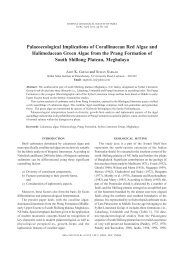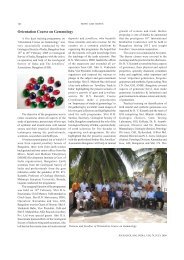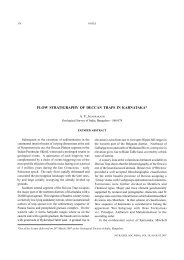mise-a-la-masse— a cost effective method in mineral exploration
mise-a-la-masse— a cost effective method in mineral exploration
mise-a-la-masse— a cost effective method in mineral exploration
You also want an ePaper? Increase the reach of your titles
YUMPU automatically turns print PDFs into web optimized ePapers that Google loves.
NOTES 203<br />
MISE-A-LA-MASSE — A COST EFFECTIVE METHOD IN MINERAL EXPLORATION*<br />
DINESH GUPTA<br />
Geological Survey of India Tra<strong>in</strong><strong>in</strong>g Institute<br />
15-16, Jha<strong>la</strong>na Doongri, Jaipur - 302 004<br />
Email: d<strong>in</strong>eshguptagsi@vahoo.com.<strong>in</strong><br />
Extended Abstract<br />
Exploration <strong>cost</strong> has <strong>in</strong>creased manifold <strong>in</strong> recent<br />
times. Diamond drill<strong>in</strong>g is the major contributor <strong>in</strong> this<br />
<strong>exploration</strong> <strong>cost</strong>. If drill<strong>in</strong>g operations could be optimized<br />
by any reliable scientific <strong>method</strong>, it can help significantly <strong>in</strong><br />
reduc<strong>in</strong>g the <strong>cost</strong> of <strong>exploration</strong>.<br />
Mise-a-<strong>la</strong>-masse is one of the geophysical <strong>exploration</strong><br />
<strong>method</strong>s, which can optimize the <strong>cost</strong>ly drill<strong>in</strong>g operations.<br />
It is a French word mean<strong>in</strong>g ‘excitation of mass’ and is a<br />
post-discovery <strong>method</strong>, s<strong>in</strong>ce the prior knowledge of<br />
existence of a m<strong>in</strong>eralised zone is necessary.<br />
The pr<strong>in</strong>ciple (Gupta et al. 1999) of this <strong>method</strong> of m<strong>in</strong>eral<br />
<strong>exploration</strong> is to p<strong>la</strong>nt one current electrode <strong>in</strong> a borehole<br />
pass<strong>in</strong>g through a sulphide deposit. The other current<br />
electrode is kept at <strong>in</strong>f<strong>in</strong>ity and the result<strong>in</strong>g<br />
potential distribution is measured for constant or<br />
normalized current by keep<strong>in</strong>g one of the potential electrodes<br />
also at <strong>in</strong>f<strong>in</strong>ity. The equipotential maps <strong>in</strong> such cases are<br />
good <strong>in</strong>dicators of the strike length, dip and pitch of the<br />
ore body afford<strong>in</strong>g a tool for def<strong>in</strong><strong>in</strong>g the shape of the<br />
ore body <strong>in</strong> three dimension.<br />
Mise-a-<strong>la</strong>-masse <strong>method</strong> was first used by Schlumberger<br />
<strong>in</strong> 1920 (Parasnis, 1966). Very limited <strong>in</strong>formation was avai<strong>la</strong>ble<br />
<strong>in</strong> literature on this <strong>method</strong> (McMurray and Hoag<strong>la</strong>nd, 1956;<br />
Gamer, 1963; Parasnis, 1967; Keto<strong>la</strong>, 1972; Pelton and Hallof,<br />
1972; Crown et al. 1975; Mans<strong>in</strong>ha and Mwenifumbo, 1983;<br />
Elloranta, 1985).<br />
In Geological Survey of India, this <strong>method</strong> is be<strong>in</strong>g<br />
extensively applied <strong>in</strong> m<strong>in</strong>eral <strong>exploration</strong> of base metals<br />
and sulphide hosted gold m<strong>in</strong>eralisation <strong>in</strong> Rajasthan. Lode<br />
geometry of the m<strong>in</strong>eralised lenses is del<strong>in</strong>eated by<br />
energiz<strong>in</strong>g the <strong>in</strong>tersected m<strong>in</strong>eralized zone <strong>in</strong> one borehole<br />
and its prognosticated extension has been proved by<br />
subsequent drill<strong>in</strong>g operations.<br />
METHODOLOGY<br />
Mise-a-<strong>la</strong>-masse surveys are carried out by IP (Time<br />
Doma<strong>in</strong>), Sc<strong>in</strong>trex unit TSQ-3 (3KW). One of the current<br />
electrodes say C1 (the positive electrode) is p<strong>la</strong>nted <strong>in</strong> the<br />
m<strong>in</strong>eral1sed part of a borehole. The other current electrode<br />
C2 (negative electrode) is located more than 1 km away from<br />
the borehole <strong>in</strong> the up dip side (Fig.1).<br />
Fig.1. Electrode configuration used <strong>in</strong> Mise-a-<strong>la</strong>-masse <strong>method</strong>.<br />
One of the potential electrodes P2 should also be kept at<br />
a great distance from the chosen borehole on the opposite<br />
side of C2, Surface potentials are measured with respect to<br />
the <strong>in</strong>f<strong>in</strong>ity electrode preferably over a grid around the<br />
borehole, The current electrode <strong>in</strong> the borehole consists of<br />
a metal rod (lead is preferred) attached to an <strong>in</strong>su<strong>la</strong>ted flexible<br />
copper wire. The observed potentials on the ground are<br />
normalized for lA current and equipotential maps then<br />
prepared.<br />
EXPLORATION BY MISE-A-LA-MASSE<br />
Mise-a-<strong>la</strong>-masse surveys have been successfully<br />
employed <strong>in</strong> <strong>exploration</strong> for base metal and sulphide-hosted<br />
gold <strong>in</strong> Rajasthan. Extensions, dip, pitch and shape of the<br />
ore bodies have been deciphered. The results presented are<br />
of <strong>mise</strong>-a-<strong>la</strong>-masse surveys carried out <strong>in</strong> Timaranmata<br />
*Lecture delivered at the monthly meet<strong>in</strong>g of the Geological Society at Bangalore on 25 October 2006.<br />
JOUR.GEOL.SOC.INDIA, VOL.69, JAN. 2007
204 NOTES<br />
sulphide hosted gold (Bhukia gold extension), Kayar Lead-<br />
Z<strong>in</strong>c (Ajmer district, Rajasthan), Sawar Lead-Z<strong>in</strong>c (Ajmer<br />
district, Rajasthan) and Bhukia gold, Banswara district,<br />
Rajasthan) prospects.<br />
In Timaranmata (E) block the total strike length of ore<br />
body del<strong>in</strong>eated is more then 550m. In this case, 100 m grid<br />
of drill<strong>in</strong>g could have been <strong>in</strong>creased up to 200 or 250 m<br />
<strong>in</strong>terval and as a result the sav<strong>in</strong>g of at least 3 additional<br />
boreholes, which is a significant sav<strong>in</strong>g and contribution.<br />
In Kayar area, the results clearly <strong>in</strong>dicate that both<br />
boreholes KYR 19 and KYR 20 (<strong>in</strong>termediate zone)<br />
<strong>in</strong>tersected one and the same lode. Proper p<strong>la</strong>nn<strong>in</strong>g of the<br />
boreholes <strong>in</strong> light of these <strong>mise</strong>-a-<strong>la</strong>-masse results could<br />
have saved the <strong>cost</strong> of <strong>in</strong>terven<strong>in</strong>g boreholes.<br />
In Bhukia area, seven boreholes were drilled to ascerta<strong>in</strong><br />
the total strike length of the sulphide body. If only two<br />
boreholes BHU 1 and BHU 10 were drilled and <strong>mise</strong>-a-<strong>la</strong>masse<br />
surveys carried out, total strike length of the ore<br />
body could have been del<strong>in</strong>eated and thus sav<strong>in</strong>g the <strong>cost</strong><br />
of five boreholes. Mise-a-<strong>la</strong>-masse surveys <strong>in</strong> two boreholes<br />
have saved the <strong>cost</strong> of five boreholes, which itself is the<br />
<strong>cost</strong> <strong>effective</strong>ness of the <strong>method</strong>.<br />
In Sawar area, a new bl<strong>in</strong>d zone was del<strong>in</strong>eated<br />
based on the results of <strong>mise</strong>-a-<strong>la</strong>-masse survey results<br />
and a borehole SWK-5 drilled exclusively on these<br />
recommendations <strong>in</strong>tersected a 20 m thick sulphide zone<br />
with >5% TMC.<br />
Mise-a-<strong>la</strong>-masse surveys <strong>in</strong> some of the boreholes of a<br />
prospect may thus help <strong>in</strong> optimiz<strong>in</strong>g the <strong>cost</strong>ly diamond<br />
drill<strong>in</strong>g operations and thus result<strong>in</strong>g <strong>in</strong> sav<strong>in</strong>g the <strong>cost</strong> of<br />
many boreholes without <strong>in</strong> any way affect<strong>in</strong>g the quality of<br />
<strong>exploration</strong>.<br />
References<br />
BHATTACHARYA, B.B., GUPTA, DINESH, RADHE SHYAM and Banerjee,<br />
B. (2001) Mise-a-<strong>la</strong>-masse surveys for auriferous sulphide <strong>in</strong><br />
Bhukia area, Banswara district, Rajasthan. Geophysics (The<br />
Journal of the Society of Exploration Geophysicist, Okh<strong>la</strong>homa,<br />
v.66. no.l-(Jan.-Feb.2001), pp.1-8.<br />
COWAN, D.R., ALLCHURCH, P.D. and OMNES, G. (1975) An <strong>in</strong>tegrated<br />
geoelectric survey on the Nangoroo copper z<strong>in</strong>c prospect near<br />
Western Australia. Geo<strong>exploration</strong>, v.13, pp.77-98.<br />
ELLORANTA, E.H. (1985) A Comparison between Mise-a-<strong>la</strong>-masse<br />
anomalies obta<strong>in</strong>ed by pole-pole and pole-dipole electrode<br />
configuration. Geo<strong>exploration</strong> v.23, pp.471-481.<br />
GARNER, L. (1963) Apparatus for electric potential <strong>in</strong>vestigation.<br />
Geo<strong>exploration</strong>, v.2, pp.32-39.<br />
GROVER, A.K. and VERMA, R.G. (1993) Gold m<strong>in</strong>eralisation <strong>in</strong> the<br />
Precambrian (Bhukia area) of southeastern Rajasthan, a new<br />
discovery. Jour. Geol. Soc. India, v.42, No.3, pp.281-288.<br />
GUPTA, D. and RADHE SHYAM (1993a) A note on borehole logg<strong>in</strong>g<br />
and Mise-a-<strong>la</strong>-masse survey <strong>in</strong> borehole KYR-20, Kayar area,<br />
Ajmer district, Rajasthan. Geol. Surv. India, Unpubl. Report.<br />
GUPTA, D. and RADHE SHYAM (1993b) A provisional note on borehole<br />
logg<strong>in</strong>g and Mise-a-<strong>la</strong>-masse survey <strong>in</strong> borehole BHU I <strong>in</strong><br />
Bhukia area, Banswara district, Rajasthan, Geol. Surv. India,<br />
Unpubl. Report.<br />
GUPTA, D. and SINGH, S.K. (1994) A provisional note on borehole<br />
logg<strong>in</strong>g and Mise-a-<strong>la</strong>-masse survey <strong>in</strong> borehole BHU 8 <strong>in</strong><br />
Bhukia area Banswara district, Rajasthan. Geol. Surv. India,<br />
Unpubl. Report.<br />
GUPTA DINESH, RADHE SHYAM, AGARWAL, A.K., BHATTACHARYA, B.B.<br />
and BANERJEE,B. (1999) Pr<strong>in</strong>ciples of Mise-a-<strong>la</strong>-masse <strong>method</strong><br />
and its application to polymetallic Sulphide deposits of<br />
Rajasthan. Jour. Geol. Soc. India, v.53, pp.49-57.<br />
GUPTA, D. and RADHE SHYAM (1999) A provisional note on borehole<br />
logg<strong>in</strong>g and Mise-a-<strong>la</strong>-masse survey <strong>in</strong> borehole TME 11 <strong>in</strong><br />
Timaranmata (East) block Bhukia extension area, Banswara<br />
district, Rajasthan. Geol. Surv. India, Unpubl. Report.<br />
GUPTA, D., RADHE SHYAM, AGRAWAL, A.K. and RAMGOPAL (2002)<br />
Del<strong>in</strong>eation of subsurface geometry of a m<strong>in</strong>eralised body by<br />
Mise-a-<strong>la</strong>-masse <strong>method</strong> <strong>in</strong> Kayar z<strong>in</strong>c-lead prospect, Ajmer<br />
district, Rajasthan. Proc. Golden Jubilee Sem<strong>in</strong>ar on<br />
<strong>exploration</strong>, Geophysics <strong>in</strong> GSI held <strong>in</strong> Calcutta.<br />
KETOLA, M. (1972) Some po<strong>in</strong>ts of view concern<strong>in</strong>g Mise-a-<strong>la</strong>masse<br />
measurements. Geo<strong>exploration</strong>, v.10, pp.1-21.<br />
MANSINHA, and MWENIFUMBO, C.J. (1983) A Mise-a-<strong>la</strong>-masse study<br />
of the Cavendish geophysical test site. Geophysics, v.48, No.9,<br />
pp.12553-12578.<br />
MCMURRAY, H.V. and HOAGLAND, A.D. (1956) Three-dimensional<br />
applied potential Studies at Austivilli, Virg<strong>in</strong>ia. GSA Bull.,<br />
v.67 pp.683-969.<br />
PARASNIS, D.S. (1966) M<strong>in</strong><strong>in</strong>g Geophysics. Elsevier.<br />
PARASNIS, D.S. (1967) Three dimensional electrical Mise-a-<strong>la</strong>-masse<br />
surveys of an irregu<strong>la</strong>r lead-z<strong>in</strong>c-copper deposit <strong>in</strong> central<br />
Sweden. Geophysical Prospect<strong>in</strong>g, v.15, pp.407-437.<br />
PELTON, W.H. and HALLOF, P.G. (1972) The applied potential <strong>method</strong><br />
<strong>in</strong> the search for massive sulphides at York Harbour, New<br />
Found<strong>la</strong>nd. Trans. SMF/AIME, v.252, pp.121-124.<br />
RAMGOPAL and GUPTA, D. (1992) A note on borehole logg<strong>in</strong>g and<br />
Mise-a-<strong>la</strong>-masse survey <strong>in</strong> borehole KYR 19, Kayar area,<br />
Ajmer district, Rajasthan. Geol. Surv. India Unpubl. Report.<br />
JOUR.GEOL.SOC.INDIA, VOL.69, JAN. 2007

















